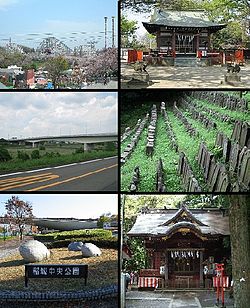Inagi
Inagi
稲城市 | |
|---|---|
 Clockwise from top left: Yomiuri Land Amusement Park, Aoi Shrine, Stone Buddha Statue in Mount Arigata, Anazawa-ten Shrine, Inagi Central Park, Inagi Bridge | |
|
UTC+9 (Japan Standard Time) | |
| Symbols | |
| • Tree | Ginkgo biloba |
| • Flower | Pyrus pyrifolia |
| Phone number | 042-378-2111 |
| Address | 2111 Higashi-Naganuma, Inagi-shi, Tokyo 206-8601 |
| Website | Official website |

Inagi (稲城市, Inagi-shi) is a
Geography
Inagi is located in the south-central portion of
Surrounding municipalities
Climate
Inagi has a humid subtropical climate (Köppen Cfa) characterized by warm summers and cool winters with light to no snowfall. The average annual temperature in Inagi is 14.3 °C. The average annual rainfall is 1647 mm with September as the wettest month. The temperatures are highest on average in August, at around 25.6 °C, and lowest in January, at around 3.2 °C.[2]
Demographics
Per Japanese census data,[3] the population of Inagi has increased steadily since the 1950s.
| Year | Pop. | ±% |
|---|---|---|
| 1950 | 9,824 | — |
| 1960 | 11,012 | +12.1% |
| 1970 | 30,817 | +179.8% |
| 1980 | 48,154 | +56.3% |
| 1990 | 58,635 | +21.8% |
| 2000 | 69,235 | +18.1% |
| 2010 | 84,835 | +22.5% |
| 2020 | 93,151 | +9.8% |
History
The area of Inagi has been settled since the
On April 1, 1957, Inagi Village was promoted to town status, and to city status on November 1, 1971.
Government
Inagi has a
Elections
Economy
Inagi is largely a
Education
Tertiary:
The Tokyo Metropolitan Government Board of Education operates one high school:
Previously Inagi High School existed.
Inagi has twelve public elementary schools and six public junior high schools operated by the Inagi City Board of Education.
Municipal junior high schools:[4]
- Inagi No. 1 (稲城第一中学校)
- Inagi No. 2 (稲城第二中学校)
- Inagi No. 3 (稲城第三中学校)
- Inagi No. 4 (稲城第四中学校)
- Inagi No. 5 (稲城第五中学校)
- Inagi No. 6 (稲城第六中学校)
Municipal elementary schools:[4]
- Hirao (平尾小学校)
- Inagi No. 1 (稲城第一小学校)
- Inagi No. 2 (稲城第二小学校)
- Inagi No. 3 (稲城第三小学校)
- Inagi No. 4 (稲城第四小学校)
- Inagi No. 6 (稲城第六小学校)
- Inagi No. 7 (稲城第七小学校)
- Koyodai (向陽台小学校)
- Minamiyama (南山小学校)
- Nagamine (長峰小学校)
- Shiroyama (城山小学校)
- Wakabadai (若葉台小学校)
There is one private junior-senior high school:
Transportation
Railway
![]() Keio Corporation - Keio Sagamihara Line
Keio Corporation - Keio Sagamihara Line
- Keiō-Yomiuri-Land - Inagi
Highway
 Chūō Expressway - Inagi IC
Chūō Expressway - Inagi IC
Local attractions
- Yomiuriland Amusement Park
Sports
- Tokyo Verdy, men's football team
- NTV Beleza, women's football team
Notable people from Inagi
- Kunio Okawara, anime mechanical designer
References
- ^ "Inagi city official statistics" (in Japanese). Japan.
- ^ Inagi climate data
- ^ Inagi population statistics
- ^ a b "教育". Inagi City. Retrieved 2022-12-11.
External links
- Inagi City Official Website (in Japanese)
